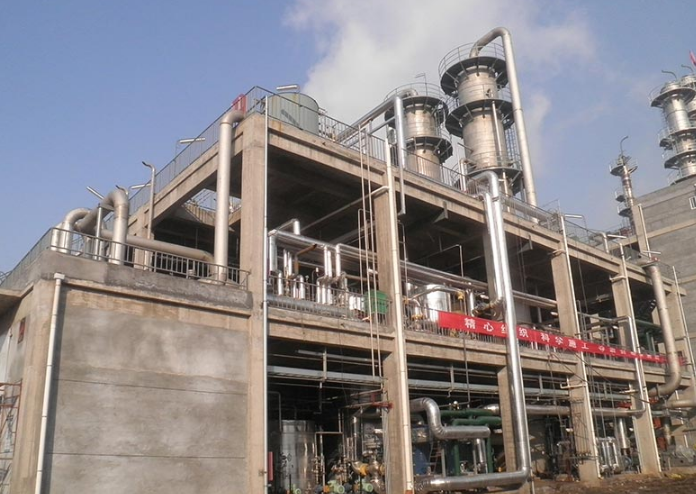Improving the performance of a formaldehyde plant requires a multifaceted approach involving various aspects of operations, technology, maintenance, safety, and sustainability. Here's an in-depth exploration of strategies to enhance the performance of a formaldehyde plant, focusing on critical areas and detailed measures to optimize its efficiency and productivity.

One-stop Package Solutions Formaldehyde Plant
1. Process Optimization:
The heart of a formaldehyde plant lies in its production processes. Process optimization is vital for maximizing output and ensuring consistent quality.
Raw Material Quality Assurance:
Ensuring a steady supply of high-quality raw materials, particularly methanol, is paramount. Rigorous quality checks and partnerships with reliable suppliers are essential to maintain production standards and minimize variations.
Reaction Conditions Enhancement:
Fine-tuning the reaction conditions within the reactor is pivotal. Parameters such as temperature, pressure, and catalyst efficiency significantly influence formaldehyde yield. Regular assessments and experiments to optimize these variables can substantially enhance overall production efficiency.
Energy Efficiency Measures:
Implementing energy-efficient practices is key to reducing operational costs and environmental impact. Adoption of advanced technologies, heat recovery systems, and process optimization for minimal energy consumption contribute to sustainability while enhancing the plant's economic viability.
2. Equipment Maintenance and Upgradation:
Maintaining and upgrading equipment play crucial roles in ensuring the plant operates at its optimum capacity with minimal downtime.
Scheduled Maintenance:
Establishing a robust maintenance schedule for critical equipment like reactors, distillation columns, scrubbers, and pumps is vital. Routine checks, preventive maintenance, and timely replacements of worn-out parts are essential to prevent unexpected breakdowns and maintain continuous operations.
Technology Upgradation:
Consider investing in modernization by upgrading equipment and integrating advanced technologies. Automation, data analytics, and remote monitoring systems can significantly improve operational efficiency, reliability, and safety.
3. Quality Control and Safety Measures:
Maintaining stringent quality control measures and prioritizing safety protocols are imperative in a formaldehyde plant setting.
Quality Assurance Processes:
Implement comprehensive quality control processes throughout the production line. Regular sampling, testing, and analysis of the final product ensure adherence to industry standards and the consistent delivery of high-quality formaldehyde.
Safety Protocol Adherence:
Prioritize employee safety by strictly enforcing safety protocols, conducting regular safety audits, and providing continuous training on handling hazardous materials. Emergency response plans and equipment must be readily available and regularly reviewed.
4. Environmental Impact Mitigation:
Addressing environmental concerns associated with formaldehyde production is crucial for sustainable operations.
Emission Control:
Invest in state-of-the-art emission control technologies to minimize air and water pollution. Continuous monitoring and compliance with stringent emission regulations are essential to mitigate environmental impact.
Waste Management Strategies:
Develop effective waste management systems to handle by-products and waste materials responsibly. Recycling or proper disposal methods must align with environmental regulations to minimize adverse ecological effects.
5. Process Integration and Optimization:
Maximizing resource utilization and minimizing waste generation through process integration is a sustainable practice for efficient operations.
Integration of Processes:
Explore opportunities for integrating different production processes within the plant. Synergizing operations and maximizing resource utilization not only optimize efficiency but also reduce operational costs.
Continuous Improvement Initiatives:
Encourage a culture of continuous improvement among employees. Establish platforms for suggestions and ideas, promoting innovation, and implementing efficiency-enhancing strategies that contribute to ongoing improvements in operations.
6. Data Analytics and Monitoring Systems:
Utilizing advanced data analytics and monitoring systems aids in real-time decision-making and proactive maintenance.
Real-time Monitoring:
Implement sophisticated monitoring systems to track key performance indicators (KPIs) in real-time. Analyzing data enables prompt identification of inefficiencies, facilitating timely corrective actions.
Predictive Maintenance Strategies:
Utilize predictive analytics and sensor technologies for predictive maintenance. Predicting equipment failures before they occur minimizes downtime and optimizes maintenance schedules, ensuring uninterrupted operations.
7. Operational Efficiency Improvement:
Efforts to streamline operations and optimize the supply chain contribute significantly to overall plant performance.
Streamlined Production Processes:
Conduct comprehensive process analysis to identify bottlenecks and inefficiencies. Implement lean manufacturing principles and process optimization strategies to streamline operations, reduce waste, and enhance efficiency.
Supply Chain Optimization:
Forge strong partnerships with reliable suppliers to ensure a steady and high-quality supply of raw materials. Streamlining the supply chain minimizes disruptions and supports consistent plant performance.
8. Employee Training and Development:
Investing in the skills and knowledge of the workforce is critical for a high-performing formaldehyde plant.
Skill Enhancement Programs:
Provide comprehensive training programs to enhance the skills of plant personnel. Well-trained employees operate machinery effectively and efficiently troubleshoot issues, contributing to improved plant performance.
Knowledge Sharing Initiatives:
Foster an environment that encourages knowledge sharing among employees. Platforms for sharing experiences and ideas facilitate innovation and the adoption of best practices, leading to continuous improvement in plant operations.
9. Research and Development Initiatives:
Investing in research and development (R&D) fosters innovation and drives improvements in processes and technologies.
Innovation and Research Focus:
Allocate resources to R&D efforts aimed at discovering new production methods, catalysts, or technologies. Pilot studies can test new methods on a smaller scale before full-scale implementation, minimizing risks and optimizing outcomes.
Collaboration and Engagement:
Engage in collaboration with industry experts, research institutions, and associations to stay updated on emerging trends, regulations, and technological advancements. Active involvement in the industry community fosters innovation and continuous improvement.
10. Stakeholder Collaboration:
Collaboration with stakeholders, including regulatory bodies and industry peers, is essential for sustainable operations.
Engagement with Regulatory Authorities:
Maintain proactive engagement with regulatory bodies to ensure compliance with evolving environmental and safety regulations. Establishing open communication channels ensures alignment with standards and regulations, securing the plant's long-term sustainability.
Conclusion:
Enhancing the performance of a formaldehyde plant demands a comprehensive and integrated approach. Addressing process optimization, equipment maintenance, quality control, safety protocols, environmental impact, employee training, innovation, and stakeholder collaboration collectively contributes to achieving operational excellence.
By implementing these multifaceted strategies, formaldehyde plants can significantly improve their efficiency, productivity, safety standards, and sustainability practices, thereby securing a competitive edge in the industry landscape.
















